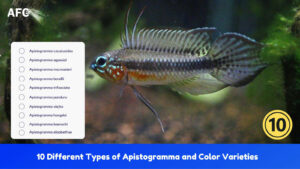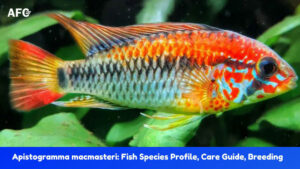If you’re looking for a fish that will add a touch of glamour to your aquarium, look no further than the peacock cichlid.
But what makes them so special? For one, their iridescent scales are simply stunning, and they come in a wide variety of colors. They’re also relatively easy to care for, which makes them ideal for beginner aquarists.
If you’re looking for a show-stopping addition to your aquarium, the peacock cichlid is definitely the way to go.
However, when you’re in the local fish store looking for your new aquatic friend, you might notice that there are both male and female peacock cichlids. So, which one should you choose? What’s the difference between them?
To answer your questions, let’s take a closer look at the female peacock cichlid.
How to Tell If Your Peacock Cichlids are Male or Female?

Male peacock cichlids are more colorful and are more aggressive in nature. They are generally larger than the female peacock cichlids. The males also have longer and sharper dorsal and anal fins. To 100% accurately sex your peacock cichlids, you would need to look at their genitalia. This can be done by gently holding your fish and ever so slightly squeezing their abdomens until their vent opens. If you see a tubular projection, then you have a male on your hands. Female peacock cichlids, on the other hand, will have a roundish opening.
Size
The male peacock cichlid is generally larger than the female. The average size of a male peacock cichlid can be 6 inches (15.2 cm), with females typically only growing to 4 inches (10.16 cm) when fully grown.
Coloration
The peacock cichlid is a stunning-looking fish. They have multi-colored scales that shimmer and shine in the light. Female peacock cichlids are not as brightly colored as their male counterparts. The colors on a female’s body will be more muted and subdued when compared to a male’s.
But what you may not know is that many of these fish that come into the aquarium stores have been treated with testosterone to bring out their dominant male coloration. Over time, they often fade back to the female or subordinate male coloration.
Body Shape
Both males and females have similar long, stocky bodies. The main difference between them is that the males typically have a larger head and smaller abdomen.
Fins
Unlike the male Peacock Cichlids, whose dorsal fins and anal fins are longer growing towards the middle and end, female peacock cichlids have short dorsal fins towards the end. To add, the pelvic, anal, and dorsal fins of females are blunt.
Egg Spots
The most obvious difference between a male and female peacock cichlid is the presence of egg spots on the anal fins of males, which are used to attract females. However, some females specimens can also show these same egg spots.
Vent
As we mentioned earlier, the most accurate way to know if your peacock cichlid is a male or female is by looking at their vent. The vent is an opening on the underside of the fish, just behind the anus, through which they expel wastes and also release eggs and sperm during breeding.
If you take a look at a peacock cichlid’s vent, you will notice that males have two identical sized holes, their male organ, and anus. In comparison, females have two different sized holes, a bigger “egg tube” and a smaller anus.
Author notes: Like most fish, you can’t really vent young peacock cichlids.
Fun Facts About Female Peacock Cichlids
Male peacock cichlids are known for their beautiful colors and their fancy fins. They use these features to charm and impress the females into mating with them. However, females aren’t as colorful as their male counterparts and aren’t as fancy. But, they have their own unique traits that will change the way you look at them.
In this section, I take you through the unique traits of female peacock cichlids.
Female Peacock Cichlid Size
How big do female peacock cichlids get depending on the different varieties. This section will only share some info about the most popular varieties.
| Variations | Size |
|---|---|
| Aulonocara jacobfreibergi “Eureka” | 6″ (15 cm) |
| Aulonocara jacobfreibergi “Eureka albino” | 4 – 6 inches (10 – 15 cm) |
| Aulonocara jacobfreibergi “Undu Reef” | 5″ (13 cm) |
| Aulonocara jacobfreibergi “Otter Point” | 6″ (15 cm) |
| Aulonocara jacobfreibergi “Hongi Island” | 6″ (15 cm) |
| Aulonocara jacobfreibergi “Cape Kaiser” | 7″ (18 cm) |
How to Tell If a Female Peacock Cichlid is Pregnant?
I have personally kept the peacock cichlid, and this is the most beautiful fish I have ever seen. Pregnant female peacock cichlids are easier to tell.
Some of the signs that a female peacock cichlid is pregnant are her protruding abdomen, dull coloration, and preference to stay in the cave.
Also, a pregnant female peacock cichlid will be seen sitting up in the tank or in a corner, or they will be on their own, not interacting with other fish.
I also noticed that they lose appetite and may not eat as they normally should. They tend not to eat because they hold eggs in their mouth for an average of 21 to 28 days. Due to that, look out for fish with an extended mouth that doesn’t look normal.
But the only way to be 100% sure is to see their eggs.
How to Tell If My Female Peacock Cichlids Are Mating?
If you want to know whether female peacock cichlids are mating or not, then you need to keep a close eye on them and observe their behavior a little bit more.
Here are some of the things that can help you identify whether they are mating or not.
The first thing is to look out for signs of aggressiveness. Males will attack other male peacock cichlids and chase after the females.
Also, the male will start to do a mating “dance” and dig some ditches in the sand or gravel just to attract the females, who will then lay eggs in that spot. Afterward, the male will come and fertilize the eggs during spawning.
Once you notice the female peacock cichlids respond to the male’s advances, you can be pretty sure that they are ready to mate.
Since these fish are mouthbrooders, the female will then scoop the eggs into her mouth to protect and incubate them until they hatch.
Do Female Peacock Cichlids Have Color?
There is no consensus among the cichlid community that the female cichlids are plain. Even though the male peacock cichlids take the spotlight, there is no reason to think that the female peacock cichlids are any less beautiful.
We know for sure that the male peacock cichlids have three different color phases that are dazzling and quite attractive. The female peacock cichlids don’t have color phases and are always subdued hues.
These fish are highly variable in color, and different variables will bring out different colors in your female peacock cichlid. Take a look at some of the colors that your female peacock cichlid variables might display here: animal-world.com
Can Female Peacock Cichlids Change Gender?
Peacock cichlids can’t change their gender. This species is sexually dimorphic, which means that the male and female of the species look different from each other. When you notice the female peacock has the most bright colors as the dominant male, you may get a hormone-induced fish or a master of disguise.
Peacock Cichlids Breeding Tips
The Peacock cichlid has been bred in captivity for years. Breeding peacock cichlids is not as difficult as it may seem, but there are a few things you need to know and do in order to increase your chances of success.
In this section, I will share some tips on how to breed peacock cichlids successfully.
1. Choose healthy and compatible parents – This is probably the most important step in the whole process. You need to make sure that the parents are healthy and compatible with each other.
2. Create a suitable environment – In order for the fry to survive and thrive, you need to create a suitable environment for them. It’s best to have their own breeding tank with caves and a sandy substrate as they can be quite aggressive when they guard their eggs and babies.
4. Trigger spawning – There are a few different ways to trigger spawning in peacock cichlids. One trick you can try is to raise the water temperature to 82°F.
5. Be patient – Once the spawning is complete, it will take about 21-28 days for the fry to hatch. During this time, the female will carry the eggs in her mouth and won’t eat much.
6. Remove the parents after spawning – Once the fish have spawned, it is important to remove the parents from the tank. This is because they will often eat their own fry.
7. To prevent this from happening, you need to make sure that your cichlids are very different in shape.
Final Thoughts
Female peacock cichlids are beautiful and intriguing creatures. Although they are not as brightly colored as the males, they still have a lot of color variation. Female peacock cichlids can also change their colors depending on the environment and other variables.
I hope this blog post has helped you learn about the female peacock cichlid; Like most Lake Malawi Cichlids, these fish are great for beginning fish keepers! If you have any questions or concerns about this fish, don’t hesitate to get in touch with us anytime. We are always glad to help.





